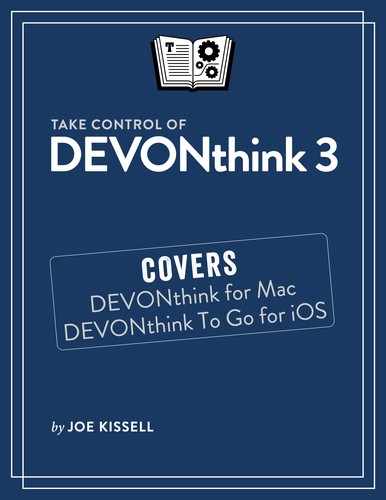Dig Deeper
Although I can’t cover every last DEVONthink feature, I want to wrap up this book with a brief discussion of a few key features that are a bit more obscure or advanced than what the average user may need on a daily basis. I hope you’ll use this information as a starting point to explore and experiment with the app on your own.
Maintain Your Databases
In certain situations, your DEVONthink databases can become corrupted. For example, if a system process DEVONthink depends on crashes while data is being written, the files may not be stored correctly or completely. Disk errors and other random events having nothing to do specifically with DEVONthink can also cause problems with your databases. If you begin noticing problems—weird error messages; missing documents, groups, or tags; or anything else that’s out of whack—you can use any of several techniques to fix them. (And, it doesn’t hurt to use these from time to time as a preventive measure, even if you haven’t noticed any problems.)
Verify & Repair Database
The File > Verify & Repair Database command checks the selected database for errors, and if it finds any, it fixes those it can. So choosing this command is a quick and easy way to solve many common problems.
During the repair process, if DEVONthink finds any files in its package on disk that don’t have corresponding entries in your database, it (re)imports them and puts them in a new group, at the top level of your database, called Orphaned Files. You can then move these newly adopted documents to the group(s) of your choice. DEVONthink also reports any missing files in Window > Log.
Optimize Database
Over time, as you add, delete, and modify items, your database can become less efficient in the way it stores your data, leading to decreasing performance. DEVONthink offers an easy way to reorganize your database’s internal structure behind the scenes—it won’t look any different afterward, but it may work better. (You needn’t do this often, perhaps every few months if the app feels a bit less zippy than usual.)
To optimize a database, select it and choose File > Optimize Database. DEVONthink creates an extra backup of your database behind the scenes and then rebuilds its structure. Normally this takes just seconds, even with a huge database. To optimize all open databases at once, go to DEVONthink’s Script ![]() > Data submenu and choose Verify & Optimize Databases (⌘-Control-Option-Y).
> Data submenu and choose Verify & Optimize Databases (⌘-Control-Option-Y).
Back Up and Restore from Backup
You should, of course, back up your DEVONthink databases by including the ~/Databases folder (or whatever folder you store them in) in your regular backups—for example, those you make using Time Machine, Carbon Copy Cloner, or Backblaze. (For extensive advice on backups, see my book Take Control of Backing Up Your Mac.) However, in addition to whatever ways you may back up your database outside DEVONthink, the app backs up its own data internally once a week (assuming you open it at least once a week).
If you’re experiencing problems with DEVONthink that the Verify & Repair Database is unable to fix, you can try restoring DEVONthink’s internal backup, which affects only your metadata, not the documents themselves. To do this, hold down Option and choose File > Restore Backup. Select a backup (DEVONthink stores two, and usually the most recent one is the logical choice), and click Open. DEVONthink reverts to the version of the metadata and index stored in that database. It doesn’t hurt, after doing this, to choose Tools > Verify & Repair again, just in case your backup was also damaged. But keep in mind that if you’ve made further changes to your DEVONthink database since that backup, they may not be reflected in DEVONthink after you restore your backup.
If you want to create an extra, manual backup of your full DEVONthink data (which you can then copy to the media of your choice), choose File > Export Database Archive, select a location, and click Save. DEVONthink stores the backup as a Zip file.
Rebuild Database
If all else fails (namely, you still see error messages or weird behavior even after Verify & Repair and Restore from Backup), your best course of action may be to ditch your index and rebuild it from the raw documents. Doing so generally preserves your group and tag structure, although some metadata may be lost.
To rebuild your database, choose File > Rebuild Database and click OK. DEVONthink exports and then re-imports all your documents.
Link DEVONthink Documents to Other Apps
You can also access particular documents in your database from another application on your Mac. Select any item and choose Edit > Copy Item Link (⌘-Control-Option-C). This puts a specially formatted URL on your clipboard. Go to that URL from anywhere else on your Mac and it opens the selected item in DEVONthink.
Why would you want to do this? I’ll give you a quick example. Calendar has a URL field for each event. If you put the link to a DEVONthink item in one of these fields, you can jump to that item—say, a report related to a meeting, or a research document you need to present at a conference—directly from Calendar. (DEVONthink’s included Reminders scripts do just this; see Included Scripts.)
